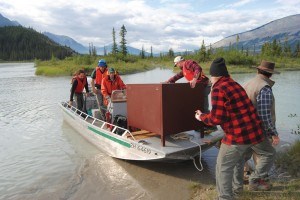
With 12,000 kms of trail, more than 2,000 structures and a backlog of projects that run off the page, maintaining Jasper National Park's trail system is no easy feat.
Leading the charge is Erin Shepherd, the trail crew coordinator, who spends countless hours toiling over spreadsheets and juggling three crews to keep on top of things.
“We have 15 people out there daily doing the work,” said Shepherd, as he took a deep breath, “Just think about that.”
Despite the enormous challenge, things are a lot better today then they were just a few years ago when government cuts nearly eliminated the trail crew all together.
“At one point the crews were down to a four-pack and activities were restricted to the Three Valley Confluence,” said Shepherd, explaining there were only four trail crew members to cover the entire park.
“In some ways we’re reinventing ourselves to fit with the new paradigm as well as trying to bring forward the best of the traditions of the old crew.”
Last week, those old traditions were brought to the fore as Shepherd joined a crew of six aboard an aluminum boat to rehabilitate Athabasca Island, which had been neglected for years.
With enough tools and lumber to open a small hardware shop and a bear box to boot, it took three trips to transport all of the tools and materials required for the two-day project.
“The Athabasca Island campground is a smaller site used almost exclusively by canoe traffic down the Athabasca River,” said Shepherd. “At this point it is in quite bad shape so we are doing an almost complete renovation of the site.”
Once settled on the sandy island, Shepherd went over the day’s plans with the crew, including the installation of a bear proof locker, establishment of two new camp pads, construction of a new picnic table, installation of a greywater pipe, removal of hazardous trees, digging of a new privy and replacement of the old fire pit.
In addition to delegating each task, Shepherd also reminded everyone about important safety rules and pointed out the easiest way to get off the island in case of an emergency, which would have included a short wade across a shallow part of the Athabasca River to Celestine Lake Road.
It was clear from the way each crew member approached their tasks that Parks Canada’s mandate to protect the ecological integrity of the park was top of mind.
While clearing and establishing two new tent pads, dozens of plant species, such as Wolf Willow, were transplanted to an older site that was too close to the food prep area. Ash from the old fire pit was also used to add nutrients to the soil and each plant was given a healthy dose of water to help them reestablish themselves.
“This project is about making the island more accessible and user-friendly,” said Emma Freeman, the trail crew supervisor.
“We’re making sure the camping spots, the cooking area and the bear bin are the appropriate distance apart so that people are safe and to keep wildlife and human conflicts at a minimum.”
At the food prep area, two crew members spent the majority of their day building a new picnic table out of pieces of rough timber from a Douglas Fir.
“It makes me feel good that I make other people’s experiences that much better in the park,” said Denis Duchesne, who has worked for the trail crew for three years.
“We create things that other people get to use for years,” he said.
Over lunch the group had a laugh about a few personal stories and Heidi Fengler, one of the trail crew members, took a moment to inform the crew about several invasive plant species that she found on the island, including Russian Thistle.
As a result of her impromptu lesson, several crew members volunteered to help pull out invasive species.
Throughout the day, there were tiny moments of sharing and collaboration like this, from learning about invasive species to the importance of blunting the tip of large spikes to prevent splitting wood.
“Everyone has their own strengths and comes from a different background so you can always teach somebody something,” said Freeman.
“It’s always about collaboration in this group.”
After lunch the crew picked up the pace, clearing overgrowth along the path, stacking wood near the fire pit and putting the finishing touches on the picnic table.
With an aggregate budget of $450,000 this year, the trail crew manages to get a lot done in a short amount of time.
“Typically what we are trying to do is run three crews of five,” said Shepherd, explaining it costs $33,000 a month to run one of those crews.
“That is our ideal situation this year, however, a four-pack has been assigned to the fire to support operations there and my one five-pack is in the Tonquin, so essentially I’m down to two three-packs.”
Even with juggling different priorities, the trail crew has tackled a number of important projects this year including, improving day use areas at Pyramid Lake Beach, improving fencing at Athabasca Falls and rebuilding wooden corduroy near Amethyst Lake in the Tonquin Valley.
At Pyramid Lake Beach the trail crew has spent several weeks improving picnic areas by cutting down a few trees, building larger picnic tables and installing new fire pits.
At Athabasca Falls new fencing was installed to stop people from climbing down to the edge of the water where several people have had close calls.
“About 90 per cent of our visitors stick to exploring areas within three kilometres of the trailhead,” said Shepherd, explaining most of the crew’s work focuses on areas of high use.
“These are the experiences they’re interested in and this is where they are making their connection with nature, so that’s important to us.”
Paul Clarke
[email protected]
